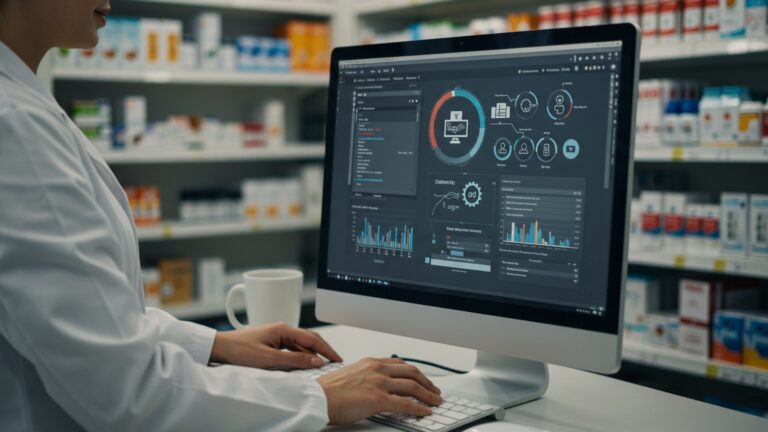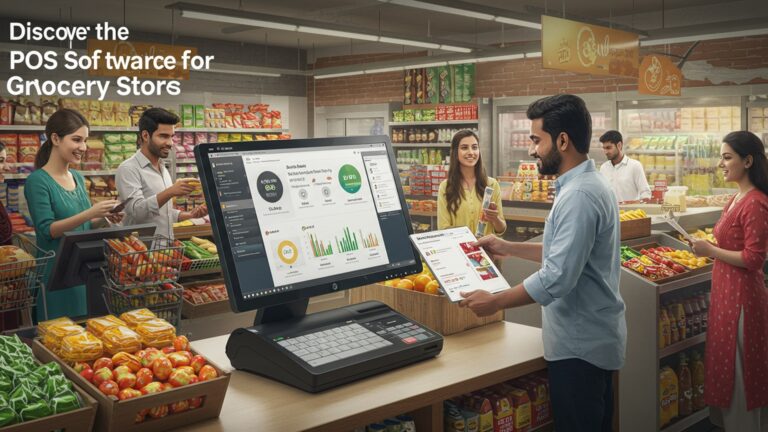What Are 6 Must-Have Restaurant POS Integrations for Modern Operations
The modern restaurant landscape demands more than just processing transactions; it requires a seamlessly integrated digital ecosystem to thrive. With the rapid rise of third-party delivery platforms and the increasing expectation for personalized customer experiences, standalone Restaurant POS software often creates operational silos. Forward-thinking establishments now leverage robust integrations, like real-time inventory synchronization and advanced loyalty program management, to unify data streams. This holistic approach not only streamlines operations, reducing manual errors and optimizing staff efficiency. also provides critical insights into purchasing patterns and customer preferences, crucial for navigating today’s competitive market and fostering sustainable growth.
Online Ordering & Delivery Platforms Integration
In today’s fast-paced digital world, a restaurant’s ability to seamlessly handle online orders is no longer a luxury but a fundamental necessity. Integrating your Restaurant POS software with online ordering and delivery platforms is perhaps one of the most impactful steps a modern operation can take. These platforms include third-party services like DoorDash, Uber Eats. Grubhub, as well as proprietary online ordering systems embedded directly into a restaurant’s website or app.
This integration connects your point-of-sale system directly with the various channels customers use to place orders remotely. Instead of staff manually re-entering orders from tablets or phone calls into the POS, the orders flow automatically.
- Streamlined Operations
- Expanded Reach & Revenue
- Improved Accuracy
- Real-time Menu Management
Eliminates the need for manual order entry, significantly reducing human error and freeing up staff to focus on customer service or food preparation.
Taps into a broader customer base beyond walk-ins, allowing you to serve customers who prefer convenience and delivery. This can directly translate to increased sales volume.
Orders are sent directly to the kitchen display system (KDS) or printer exactly as the customer entered them, minimizing mistakes and improving order fulfillment accuracy.
Allows for unified menu updates across all platforms from a single source, ensuring consistency and preventing issues with unavailable items.
Imagine a busy Friday night. Without integration, your staff might be juggling multiple tablets from different delivery apps, manually punching orders into the POS, leading to delays and potential errors. With integration, an order placed on DoorDash automatically appears on your KDS, charges the customer. updates your inventory through your Restaurant POS software, all without a single manual touch from your team. This efficiency allows your kitchen to start preparing food faster and ensures a smoother experience for both staff and customers.
Inventory Management Integration
Effective inventory management is the bedrock of profitability for any restaurant. Food costs are often the highest expense. poor inventory control can lead to significant waste and lost revenue. Integrating a robust inventory management system with your Restaurant POS software is crucial for maintaining tight control over your ingredients and supplies.
This integration links your sales data from the POS directly to your inventory system. Every dish sold automatically deducts the precise quantity of ingredients used from your stock levels.
- Accurate Costing
- Waste Reduction
- Optimized Purchasing
- Menu Engineering
Provides real-time insights into the actual cost of goods sold (COGS) for each menu item, allowing for more informed pricing decisions.
By tracking ingredient usage precisely, you can identify areas of waste, spoilage, or theft. take corrective actions.
Automatically tracks stock levels and can trigger reorder alerts when items hit a predefined minimum, preventing stockouts of popular ingredients and over-ordering of slow-moving ones.
Allows you to review the profitability of dishes based on real-time ingredient costs, helping you optimize your menu for maximum profit.
When a customer orders a “Classic Burger” through your Restaurant POS software, the integrated inventory system automatically subtracts one burger bun, one beef patty, a slice of cheese. a specific amount of lettuce and tomato from your stock. If your beef patties are running low, the system can automatically flag it for reordering, preventing you from having to tell customers you’re out of a popular item during peak hours. This level of detail helps pinpoint exactly where your food costs are going, enabling smarter purchasing and less waste.
Customer Relationship Management (CRM) & Loyalty Programs Integration
Building a loyal customer base is vital for long-term success in the competitive restaurant industry. Integrating your Restaurant POS software with CRM and loyalty programs allows you to interpret your customers better, personalize their experience. incentivize repeat business.
This integration captures customer data (purchase history, preferences, contact data) directly from transactions at the POS and feeds it into a CRM system. It also seamlessly manages loyalty points, rewards. personalized offers.
- Enhanced Customer Retention
- Personalized Marketing
- Improved Customer Experience
- Data-Driven Insights
Loyalty programs encourage repeat visits by offering rewards, discounts, or exclusive access based on past purchases.
With detailed customer profiles, you can send targeted promotions (e. g. , a birthday offer, a discount on their favorite dish) that resonate more effectively than generic ads.
Staff can access customer preferences (e. g. , “no pickles,” “gluten-free”) at the POS, allowing for a more personalized and attentive service.
comprehend customer demographics, peak visiting times. popular orders, informing marketing strategies and menu development.
A regular customer dines at your restaurant and provides their loyalty ID at the Restaurant POS software. The system instantly recognizes them, applies points to their account. perhaps even suggests their usual order. Later, because the CRM knows their birthday, it automatically sends them an email with a special offer for a free dessert, enticing them to celebrate at your establishment. This level of personalization makes customers feel valued and encourages them to choose your restaurant over competitors.
Employee Management & Scheduling Integration
Managing staff effectively is key to operational efficiency and compliance. From time tracking to scheduling and payroll, integrating employee management tools with your Restaurant POS software streamlines HR processes, reduces labor costs. improves employee satisfaction.
This integration connects the POS system, where employees clock in and out, with dedicated employee management and scheduling software. It automates time tracking, helps create optimized schedules. facilitates payroll processing.
- Accurate Time Tracking
- Optimized Scheduling
- Simplified Payroll
- Compliance
- Communication
Employees can clock in/out directly via the POS, ensuring precise records for payroll and reducing manual errors or “buddy punching.”
Use sales data and forecasted demand from the POS to create efficient schedules that match staffing levels with customer traffic, preventing overstaffing or understaffing.
Hours worked are automatically aggregated and can be exported directly to payroll systems, significantly reducing administrative time and potential discrepancies.
Helps ensure adherence to labor laws regarding breaks, overtime. working hours, reducing legal risks.
Many integrated systems offer communication tools for shift swaps, availability updates. announcements, improving team coordination.
A server clocks in for their shift using the integrated time clock feature on the Restaurant POS software. The system records their start time. At the end of the week, all employees’ clocked hours are automatically compiled by the scheduling software, which then calculates total hours, overtime. even integrates with payroll to process wages. This eliminates the need for managers to manually collect timesheets, calculate hours. enter data into separate systems, saving hours of administrative work each pay period and ensuring employees are paid accurately and on time.
Accounting Software Integration
For any business, accurate financial tracking is paramount. restaurants are no exception. Integrating your Restaurant POS software with accounting software simplifies bookkeeping, ensures financial accuracy. provides vital insights into your restaurant’s financial health.
This integration automatically syncs daily sales data, payment breakdowns, expenses. other financial transactions from your POS directly into your chosen accounting platform (e. g. , QuickBooks, Xero, Sage). This eliminates the need for manual data entry.
- Reduced Manual Data Entry
- Increased Accuracy
- Real-time Financial Insights
- Simplified Tax Preparation
- Better Financial Planning
Significantly cuts down on the time and effort required for bookkeeping, freeing up valuable staff resources.
Automates the transfer of financial data, minimizing human errors that can occur during manual transcription.
Provides up-to-date financial reports, allowing you to monitor profitability, cash flow. expenses in real-time.
All financial data is neatly organized and categorized, making tax season less stressful and more efficient.
With accurate, timely data, you can make more informed decisions regarding budgeting, investments. overall financial strategy.
At the close of business each day, your Restaurant POS software automatically sends a detailed summary of sales, payment types (cash, credit card, gift card), discounts. taxes collected directly to your QuickBooks Online account. This means your bookkeeper doesn’t have to spend hours at the end of the week or month manually entering sales receipts and categorizing transactions. The data is consistently accurate and available for generating profit and loss statements, balance sheets. other critical financial reports with minimal effort.
Analytics & Reporting Tools Integration
While most Restaurant POS software offers basic reporting, integrating with specialized analytics and reporting tools unlocks a deeper level of business intelligence. This allows you to move beyond surface-level data and uncover actionable insights that drive strategic decisions and growth.
This integration connects your POS system with advanced business intelligence (BI) platforms or specialized restaurant analytics tools. These tools aggregate data from your POS, inventory, labor. even customer interactions to provide comprehensive, customizable reports and visualizations.
- Deeper Insights
- Data-Driven Decision Making
- Identify Opportunities & Challenges
- Customizable Dashboards
- Competitive Advantage
Go beyond standard sales reports to grasp trends, peak performance times, employee performance. menu item popularity in granular detail.
Make informed choices about menu engineering, pricing strategies, staffing levels, marketing campaigns. operational improvements based on concrete data.
Spot patterns, identify underperforming dishes or staff. discover opportunities for upselling or cross-selling.
Create personalized dashboards that highlight the key performance indicators (KPIs) most relevant to your business goals.
Leverage data to continuously optimize your operations, giving you an edge in a competitive market.
By integrating your Restaurant POS software with an advanced analytics platform, you might discover that your “Chef’s Special Pasta” has a high profit margin but sells poorly on Tuesdays, while your “Vegan Bowl” sells exceptionally well during lunch on weekdays but drops off significantly in the evenings. This insight could lead you to promote the pasta on weekends or remove it from the Tuesday menu. perhaps run a lunch special on the Vegan Bowl. You can also review labor costs against sales per hour to optimize staff scheduling and boost overall efficiency, ensuring you have the right number of people at the right time to maximize service and profitability.
Conclusion
Embracing the right POS integrations isn’t merely about adding features; it’s about architecting a truly modern, efficient. profitable restaurant ecosystem. My personal tip for operators is to assess each potential integration not just for its individual function. for how it contributes to a seamless data flow across your entire business. For instance, connecting your online ordering directly to kitchen display systems and inventory management, as many savvy restaurateurs are now doing, drastically reduces manual errors and optimizes stock levels in real-time. This kind of interconnectedness is vital for navigating today’s competitive landscape, where customer expectations for speed and accuracy are higher than ever, a trend highlighted by recent industry reports on restaurant technology adoption. Don’t let the thought of implementing new tech overwhelm you. Start by identifying your biggest operational bottlenecks and then strategically select integrations that directly address those pain points. This proactive approach transforms your POS from a simple transaction tool into a powerful data hub, driving smarter decisions and enhancing every aspect of your service, from the front-of-house to the back. By choosing wisely, you’re not just upgrading software; you’re investing in a future where your restaurant operates with unparalleled precision and agility.
More Articles
Master 8 Key Strategies for Optimizing Your Restaurant POS Usage
7 Essential POS Features Restaurant Owners Must Learn to Master
How to Choose The Best Restaurant POS System A 5 Step Guide
10 Essential POS Software Features Every Restaurant Owner Needs to Know
How to Identify Top Features for a Restaurant POS System Guide
FAQs
Why should my restaurant even think about integrating different systems with its POS?
Integrating your POS with other tools streamlines operations, reduces manual errors. gives you a holistic view of your entire business. It means less time spent on administrative tasks and more on what you do best: serving great food and creating memorable experiences for your guests.
How does POS integration help with all those online orders and delivery apps?
A good POS integration pulls orders directly from your website or third-party delivery platforms right into your kitchen. This eliminates the need for manually re-entering orders, which means faster service, fewer mistakes. happier customers who get their food accurately and on time.
My inventory is a mess! Can POS integration actually make managing stock easier?
Absolutely! Integrating with an inventory management system lets you track ingredients in real-time. Every sale automatically updates your stock levels, helps you forecast future needs, identifies waste. can even trigger reorders, saving you money and preventing frustrating shortages.
What about my staff’s schedules and payroll? How can POS integrations help there?
Integrating your POS with employee management or HR software simplifies the entire process. It helps with creating schedules, accurately tracks employee hours worked, manages tips. can even feed data directly into your payroll system. This saves a ton of administrative time and ensures everyone gets paid correctly.
Will integrating my POS make my accountant happier at tax time?
Definitely! Connecting your POS to accounting software like QuickBooks or Xero automates data entry for sales, expenses. payments. This keeps your financial records accurate and up-to-date with minimal effort, making financial reporting and tax preparation much smoother and less stressful.
How can POS integrations help me build customer loyalty and keep them coming back?
Integrating with a CRM or loyalty program allows your POS to capture valuable customer data, track their purchase history. manage loyalty points or special offers seamlessly. This helps you personalize experiences, create targeted promotions. reward your best customers, encouraging repeat business.
What’s this KDS integration thing. why would my kitchen need it?
KDS stands for Kitchen Display System. Integrating your POS with a KDS sends orders directly to digital screens in your kitchen, replacing paper tickets. This improves communication between the front-of-house and back-of-house, reduces order errors, speeds up food preparation. helps your kitchen staff manage order flow efficiently, especially during peak hours.






